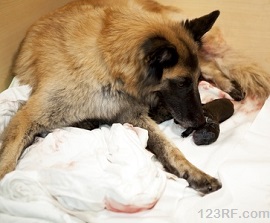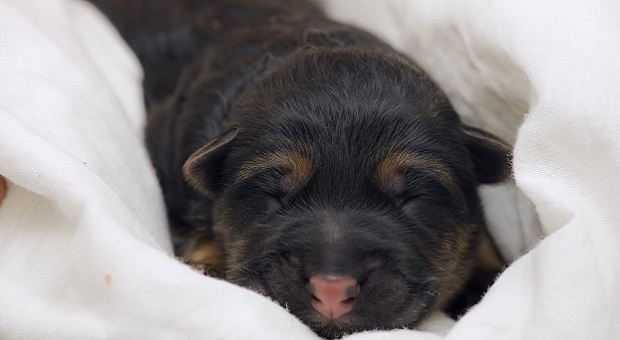You’ve decided to start your kennel and already learned a lot about how to choose the perfect breeds of dogs for survival. What about the physical aspects of your kennel and what types of areas you’ll need in order to breed, birth and raise your puppies?
Don’t worry, stay tuned and read this article!
In the first part of this series, we discussed how to decide what to breed and how to choose your puppies. And now we’re going to go into a bit more detail about breeding, training, finding good homes for your puppies, and difficulties that you may expect.
Find a Good Trainer
Once you’ve gotten your puppies, you need to find a good trainer. Chances are good that you’ll have a few months to do this but be aware that really good trainers are often booked up for several months in advance. This is footwork that you may want to do before you even get your puppy.
Again, refer to the breeders clubs that you used to find your breeder. They often offer a list of reputable trainers who, even if they’re busy, can suggest other trainers.
If you feel comfortable training your own dog, begin from the day you bring him home. Bond with him and teach him manners. When he’s old enough to start his “work” training, be diligent about it. Part-time training builds more bad habits than no training at all.
Be confident and diligent in your training and use every possible opportunity as a training opportunity and reward the dog well for a job well done, or even for a valiant effort in the beginning.
If you don’t know what you’re doing, don’t hesitate to take your dog to a trainer. Find one that’s willing to work with both you and your dog so that you can learn how to teach him while you’re at home.
Your First Breeding Experience
Just as with all animals, dogs will only breed under certain circumstances. First, let’s discuss the bitch because the potential sire is fairly simple. You can expect your bitch to come into her first heat cycle anywhere between 6 and 24 months of age and then about 6 months thereafter. Smaller dogs tend to come in earlier while larger dogs come in later.
Males have mature sperm between the ages of 6 months and 15 months old, depending upon breed. Small dogs tend to mature sexually younger than large dogs. They’re typically at their sexual prime between 15 months and 5 or 6 years old; after that, sperm starts to lessen and can’t penetrate the egg as well.
As you can see, if you start with puppies, you’ll be waiting awhile but it will be worth it because you will know exactly how your dog has been handled and whether or not it has the temperament to breed a good litter. You’ll also have the benefit of having properly trained sires and dams to show to potential buyers.
It’s not recommended that bitches be bred during their first heat cycle because her eggs aren’t yet mature; in fact, even if your dog comes into heat (or season) early, you should wait for her to reach at least 18 months of age so that she’s physically mature.
She should also pass a thorough physical before you breed her. Let her skip a heat cycle in between breedings and don’t breed her after the age of 5 because you’re risking both dam and puppies at that point.
Breeding
If you’ve never seen dogs breed, you’re going to be in for a bit of a surprise. The process involves a step called tying. This phenomenon occurs because the bulbus glandis of the male’s penis swells inside the bitch’s vagina. They are locked together for 15-20 minutes though 2 – 30 minutes is nothing to worry about. It’s common for them to turn butt to butt during this process so don’t panic. They’ll untie once the process is over.
If it’s your dam’s first time, she may panic a bit. Get down with her and calm her down. Stay calm and it will help to alleviate her fear.
You don’t need a particularly private place for this to happen though you should separate them from other dogs. Wait 24 hours before the next breeding so that the sperm can build back up.
Preparing Your Whelping Area
 When your dog goes into labor, she’s going to need a quiet spot to do so. The light should be fairly dim and the area should be padded nicely but with a top sheet or blanket that you don’t mind throwing away.
When your dog goes into labor, she’s going to need a quiet spot to do so. The light should be fairly dim and the area should be padded nicely but with a top sheet or blanket that you don’t mind throwing away.
You can wash them if you’d rather but they can get pretty messy. If she were to pick it herself, it would probably be under your bed or in your closet, so try to emulate that as much as possible if you’re trying to designate an area.
Whelping
Research your particular breed to see if they typically have difficulty whelping. You should have your vet’s number close at hand when she actually goes into labor. Once she has actually started pushing, it should only take her 2-10 minutes to birth the pup.
If it gets stuck or is breech, you need to help pull it out or it will drown. She may rest for a bit between puppies but if she appears to be in distress after she starts pushing but you can’t see a problem, call your vet. Educate yourself on this process before you have to handle it in real life.
Caring for the Puppies
This is where things can get expensive, assuming you had an easy birthing process. Puppies need shots starting at 6 weeks of age, then every 3 weeks until 16 weeks of age. The standard vaccinations include distemper, canine adenovirus-2 (hepatitis and respiratory disease), canine parvovirus-2 and rabies. There are optional shots as well but you can discuss those with your vet.
Your puppies will also need to be wormed at 2, 4, 6, 8, 12 and 16 weeks of age, then again at 6 months and 1 year. Then they should be put on a regular adult de-worming schedule.
Proper nutrition is also critical to development. Your puppies will be able to start eating solid food at about 4 weeks old in order to start the weaning process. Feed them a high quality food and you may want to wet it a bit in the beginning to make it easier for them to eat.
Finding Proper Homes for Your Puppies
 This is the hardest part of breeding, especially if you’ve become attached to the puppies. Start advertising your puppies as soon as they’re born, or even a couple of weeks before they’re born so that you can start vetting possible owners.
This is the hardest part of breeding, especially if you’ve become attached to the puppies. Start advertising your puppies as soon as they’re born, or even a couple of weeks before they’re born so that you can start vetting possible owners.
Find out about their work schedules, their experience with dogs and why, exactly, they want one of your puppies. Make sure that they have enough money to care for your puppies. You may even want to do a home visit and ask for references. You don’t want to give your puppies to just anybody.
Building Your Own Kennel
Just like your home, dog kennels can be as fancy or as simple as you’d like them to be. Remember that even if you’re keeping your dog kenneled, it still needs time out every day to run and exercise. A basic kennel involves a shelter with a run extending from it built from chain link fence.
The flooring should be something that is easy to clean yet comfortable. Make sure that it doesn’t get hot and that it doesn’t have holes big enough for your dog’s foot to go through. It should also be comfortable for the dog to walk across. Many people use rubber mats.
If your dog is going to spend a lot of time in the kennel, make it at least 10 feet long so that your dog can run a bit in it. It should also be plenty wide enough for your dog to turn comfortably around in. There are many designs available online that you can search through and emulate.
Beyond all of this, remember that dogs are sentient beings that deserve a comfortable, safe environment in which to thrive. They love their people and are great survival assets that can help with everything from personal and home protection to helping you herd and protect your livestock. Don’t take dog breeding lightly and educate yourself well before you decide to take on the task.
If you have anything to add, please feel free to do so in the comments section below.
This article has been written by Theresa Crouse for Survivopedia.





































































I raised, trained and bred German Shepherds for 20+ years. I competed at the highest levels in working dog trials, with dog sthat were temperamentally sound and excellent examples of the breed structurally. Reading this article really pisses me off. There is so much misinformation I don’t know where to start!
Before you breed any animal, you need to become an expert on the bloodlines, genetic faults, temperament,and character issues. This takes YEARS of study and involvement in the breed. Go to working trials, go to conformation shows, talk to breeders. Do not read how to become a breeder on a blog written by someone who is not one of the best breeders in the country!!!!!!!!!!!!!!!
Any dog that is to be considered for breeding should be considered an excellent example of the breed in temperament, working ability, and health/fitness/robustness. Not just a good example but an EXCELLENT example of the breed. Where is the discussion of this in the article??
That means a potential breeding animal is going to be worth a lot of money due to the time (training and evaluating), money (spent on genetic testing and other vet fees and original purchase), and effort in to PROVING the dogs worth to the breed. So do not buy a $200 puppy and expect to produce animals worth anything. In fact, don’t buy a $200 puppy and plan on breeding it at all!
If you tried to buy a good quality breeding animal that has passed all its genetic testing (breed specific) has working titles to prove it can perform the work it was originally intended to do, and has a conformation rating that proves it meet the breed standard structurally, you are looking at $5000 and up. To start.
Now keep in mind, no good breeder is going to sell you his best breeding female for any amount of money, so plan on getting a problem animal for that $5000 investment.
Or you can go with the $200 puppy bred it at 18 months like the author suggests (HORRIBLE advice) and just produce another litter of crap dogs because you have no clue WTF you are doing!
I can’t even do this any longer. I could write a book about how bad this article is, addressing and explaining how bad the advice is.
Anyone who suggests that people should go into breeding as this totally inexperienced author does is being grossly irresponsible.
Please people, leave the dog breeding to experts. If you want a companion, fine get one. But do not contribute to the over population of dogs (or cats) by producing poor quality animals. And they will be very poor quality if you follow this authors advice.
There are far too many poorly bred dogs filling animal shelters now. Do not encourage people to breed more.
We have had GSD’s for ore than two decades and have seen a large number of INBRED dogs from “casual” breeders-which we passed on.
YOU GET WHAT YOU PAY FOR in any dog. Do your research, read Gino’s article above several times! Above all, be picky about the pup you bring home and breeder you select.
“Puppy fever” is a very real buyers disease! Yeah, they are ALL cute and cuddly. Ask to see in person the bitch and the sire. If there is ANY reluctance at all, walk away from the pups as fast as you can.
Hope this helps somebody.
The lineage of the parents DOES matter, a reputable will GLADLY provide it to you before you even see the pups.
One caveat to the request to see both parents of a puppy you are considering. It is not unusual to only have the mother of the pups on site. Many times I bred my female to male dogs that I did not own, even though I had a top quality stud in my kennel. That is because the best male for your female may not be your male dog! Or, your female could be your stud dog’s daughter. I often traveled 100s of miles to other states get a female bred. So just because I did not have mom & dad on site for puppy buyers to see, that is not necessarily a bad thing.
Whenever I see an ad for “both parents on site” I know that 8 times out of 10 it’s some backyard noob who got 2 cheap dogs and made puppies with no concern for pedigrees, background, health, or anything else beyond those AKC (or more likely CKC) papers. Actually make that 10 times out of 10, because serious breeders aren’t running ads on Craigslist.